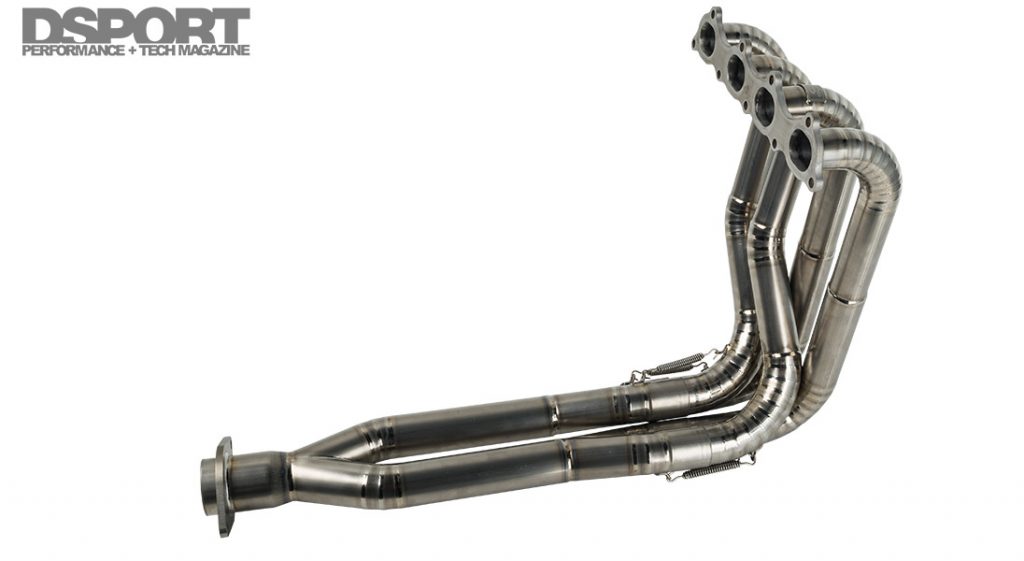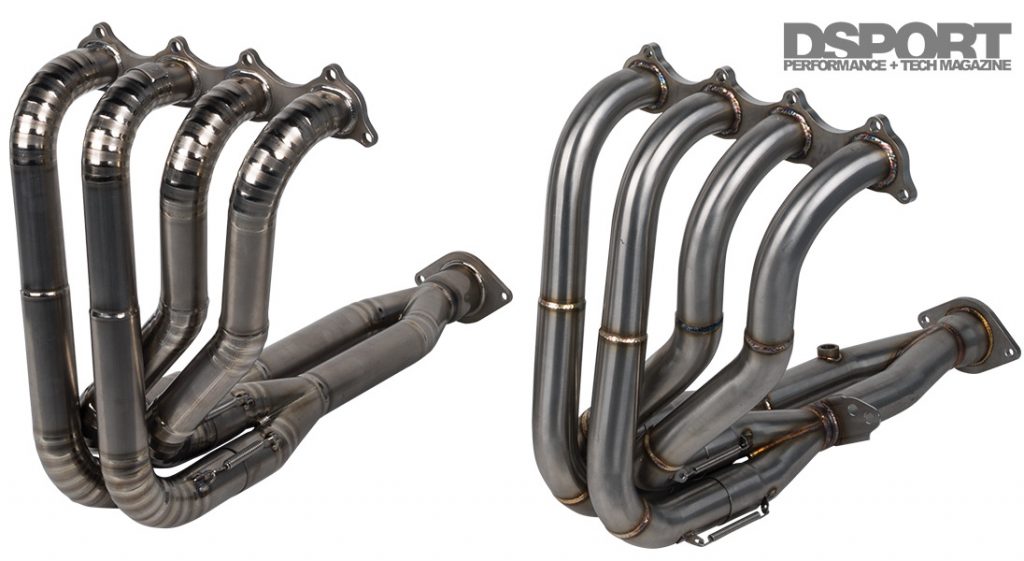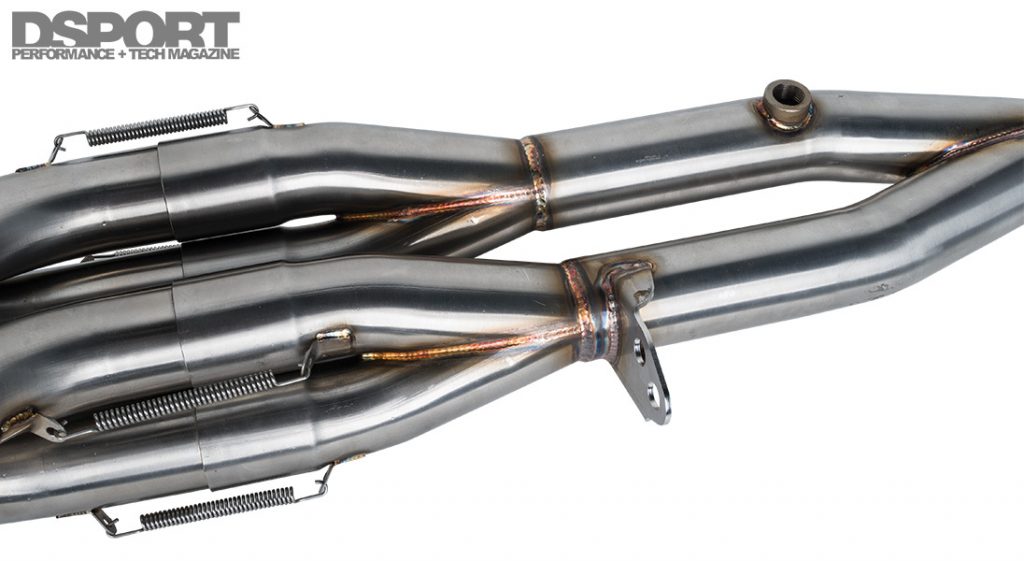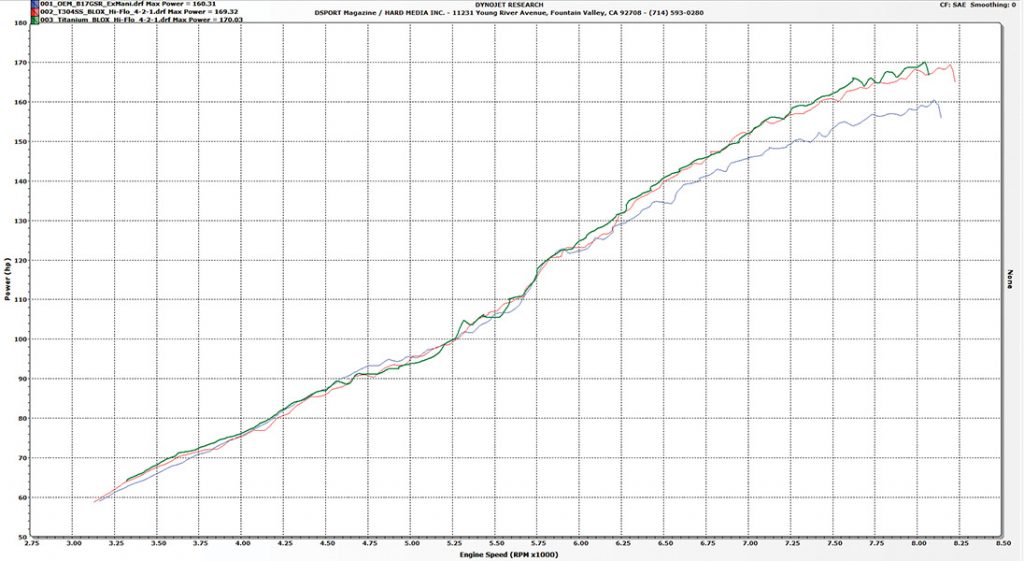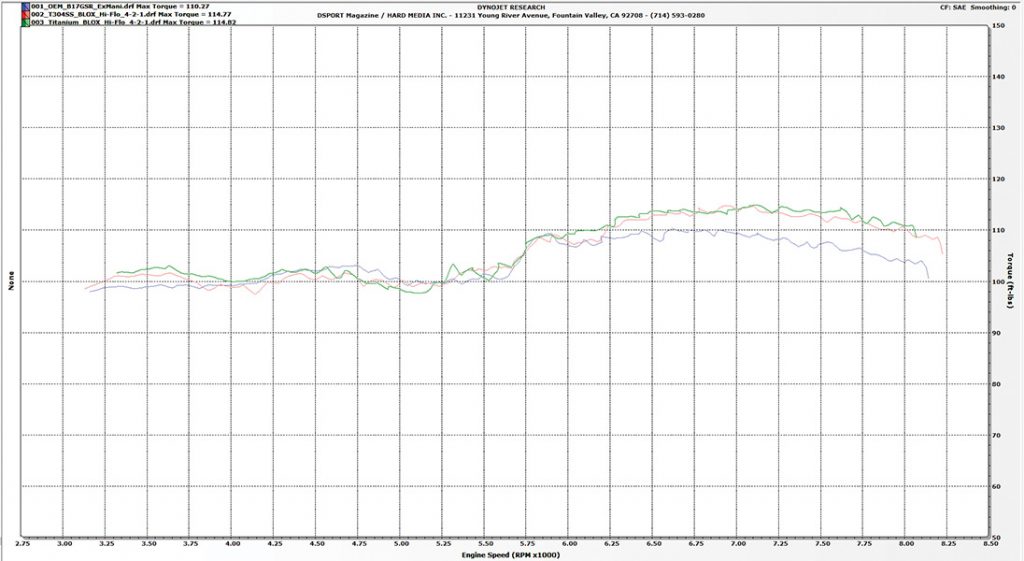While you can always turn up the boost on a forced induction application to mask a poor parts selection, an All-Motor combination relies upon the proper matching of camshafts, header, cylinder head and intake manifold. Among these four components, headers usually represent one of the first upgrades for any All-Motor build. The relative low cost and ease of installation leads to its popularity. When it comes to the Honda B-series engine, the number of header choices is overwhelming. BLOX Racing recently introduced titanium versions of its Hi-Flow and Max-Flo 4-2-1 headers and we decided it was time for a quick test.
Text by Michael Ferrara // Photos by Mikiko Akaogi and Cameron Parsons // Dyno by Aidan Spraic
DSPORT Issue #180
Header Theory
OEM exhaust manifolds are designed to provide peak efficiencies at cruising speed where the engine spends most of its life. A properly engineered high-performance header provides a tremendous opportunity to produce additional horsepower. With a well-designed header in place, additional horsepower is realized by filling the cylinder with more air and fuel and by making it easier for the engine to pump out the exhaust from the cylinder.
On four-cylinder applications, there are two basic designs of a header available. One type is known as a four-into-one (4-to-1) design. A 4-to-1 design header joins the primary pipes from all four cylinders into a common collector. The other style is known as a four-into-two-into-one design or 4-2-1 (old-timers also refer to this design as a Tri-Y design). The 4-2-1 design takes the four primary tubes and joins them to two secondary tubes. These two secondary tubes are then joined into a common collector. With all other factors being the same, a four-into-one style header will generally show its best-performance gains toward the top-end of the powerband near redline. A 4-2-1 design header generally shows performance gains across the powerband from low-to-high RPM engine speeds.
Before you think that the configuration (4-to-1 or 4-2-1) is all that matters, understand that there are at least seven other major factors that influence the performance characteristic of a header. The diameter of primary tubes, secondary tubes and collector along with the lengths of the primary tubes, secondary tubes and collector will all influence the performance characteristic of the header. In addition to this, the selection of which cylinders are paired on the 4-2-1 header design will also affect performance.
Here’s a look at the titanium and stainless-steel Hi-FLo (small tube) headers for the B-series. These are optimized for engines up to 1.9-liters.
Hi-Flow or Max-Flo
So what’s the best header to maximize performance? Engine displacement, camshaft specs, head flow characteristics and intake manifold design will determine the ideal specs for a header. Since it’s hard to have one header fit all of the various popular B-series performance configurations between 1.6 liters and 2.3 liters, BLOX Racing offers both a Hi-Flo header for 1.6- to 1.9-liter engines, along with a Max-Flo header for 2.0- to 2.3-liter engines. The difference between the two series is in the sizing of the primary, secondary and tertiary sections. The Hi-Flo uses 42mm, 45mm and 51mm section diameters for the primary, secondary and tertiary sections respectively while the Max-Flo runs 45mm, 50mm and 55mm sections. Larger displacement engines move larger masses of exhaust and the larger diameter tubes keep the exhaust gas velocities at optimum levels on the larger engines. Both of these headers are intended for competition use only and must be used OFF ROAD ONLY to comply with all state and federal laws.
The T304 header features TIG welded and 1.5mm thick tubing. The head flange is 10mm thick while the 2.5-inch diameter collector flange is 8mm thick. The Grade 1 (GR1) titanium header uses 1.0mm thick tubing with an 8mm thick head flange and 8mm-thick 2.5-inch diameter collector flange.
Test Procedure
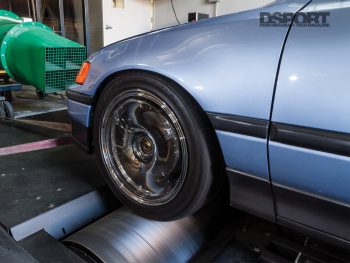 For this Quick Test, we decided to test the BLOX Racing Hi-Flo headers on our B-series swapped CRX. As you may recall, this vehicle is running a freshly-built B17 VTEC engine equipped with an AEM Induction intake system and BLOX Racing Power Intake Manifold. The camshafts and cylinder head were OEM spec. For testing purposes, we elected to not run an exhaust system (open header) in order to eliminate any possible restrictions after the header that would skew the results. Testing would be done in this order: the OEM exhaust manifold, then the standard T304 stainless-steel version of the BLOX Racing Hi-Flo header (MSRP $799.99) and finally, the new titanium version of that same BLOX Racing Hi-Flo header (MSRP $2,500).
For this Quick Test, we decided to test the BLOX Racing Hi-Flo headers on our B-series swapped CRX. As you may recall, this vehicle is running a freshly-built B17 VTEC engine equipped with an AEM Induction intake system and BLOX Racing Power Intake Manifold. The camshafts and cylinder head were OEM spec. For testing purposes, we elected to not run an exhaust system (open header) in order to eliminate any possible restrictions after the header that would skew the results. Testing would be done in this order: the OEM exhaust manifold, then the standard T304 stainless-steel version of the BLOX Racing Hi-Flo header (MSRP $799.99) and finally, the new titanium version of that same BLOX Racing Hi-Flo header (MSRP $2,500).
Installation Highlights
Both of the BLOX Racing Hi-Flow headers fit without incident. We should note that the titanium version did not include an oxygen sensor bung (this may have been addressed as our unit was one of the first built). So if you need one (as we did), be sure to get one welded in place before installation. Besides an obvious cool factor, the titanium header weighs in at just 40 percent of the weight of the stainless version; tipping the scales at just over six pounds versus 15 pounds for the stainless steel.
Power
Torque
The Dyno
Running open exhaust on our very fresh and happy B17 VTEC produced a best of 160.3 wheel horsepower (8,100 RPM) and 110.2 lb-ft (6,600 RPM) of torque with the OEM exhaust manifold in place. After installing the T304 stainless-steel version of the BLOX Racing Hi-Flo header, the vehicle was strapped back on the dyno. The BLOX Racing Hi-Flo header showed gains everywhere in the powerband with the exception of the 4,100 to 5,000 RPM range where the OEM exhaust manifold made an average of 1.5 horsepower more. Where the BLOX Racing Hi-Flo header really excelled was after the VTEC kicked in. From 6,200 to 8,200 RPM, gains of over 10whp were realized. As for peak power, the engine now made 169.3whp (8,200 RPM) and 114.8 lb-ft (6,900 RPM). After testing was completed on the T304 header, we decided to test the titanium version of the Hi-Flo header. Since the outside diameters of the tubes are the same, we didn’t expect to see much of a difference on the dyno. Surprisingly, the titanium header and its thinner wall tubing actually outperformed the stainless steel version on the order of an extra horsepower across most of the powerband. With the titanium version of the BLOX Racing Hi-Flo header, the engine now made 170.0whp (8,100 RPM) and 114.8 lb-ft (6,900 RPM).
Bottom Line
It weighs less, it performs better, but is the titanium version worth three times the price? It all depends on the value the buyer places on “cool.” We are just excited to see BLOX Racing pushing the manufacturing envelope to include this level of product. Known as being a “Honda” performance parts manufacturer for years, the company’s vision to expand to new platforms (like the FR-S/BRZ/86) is exciting.



